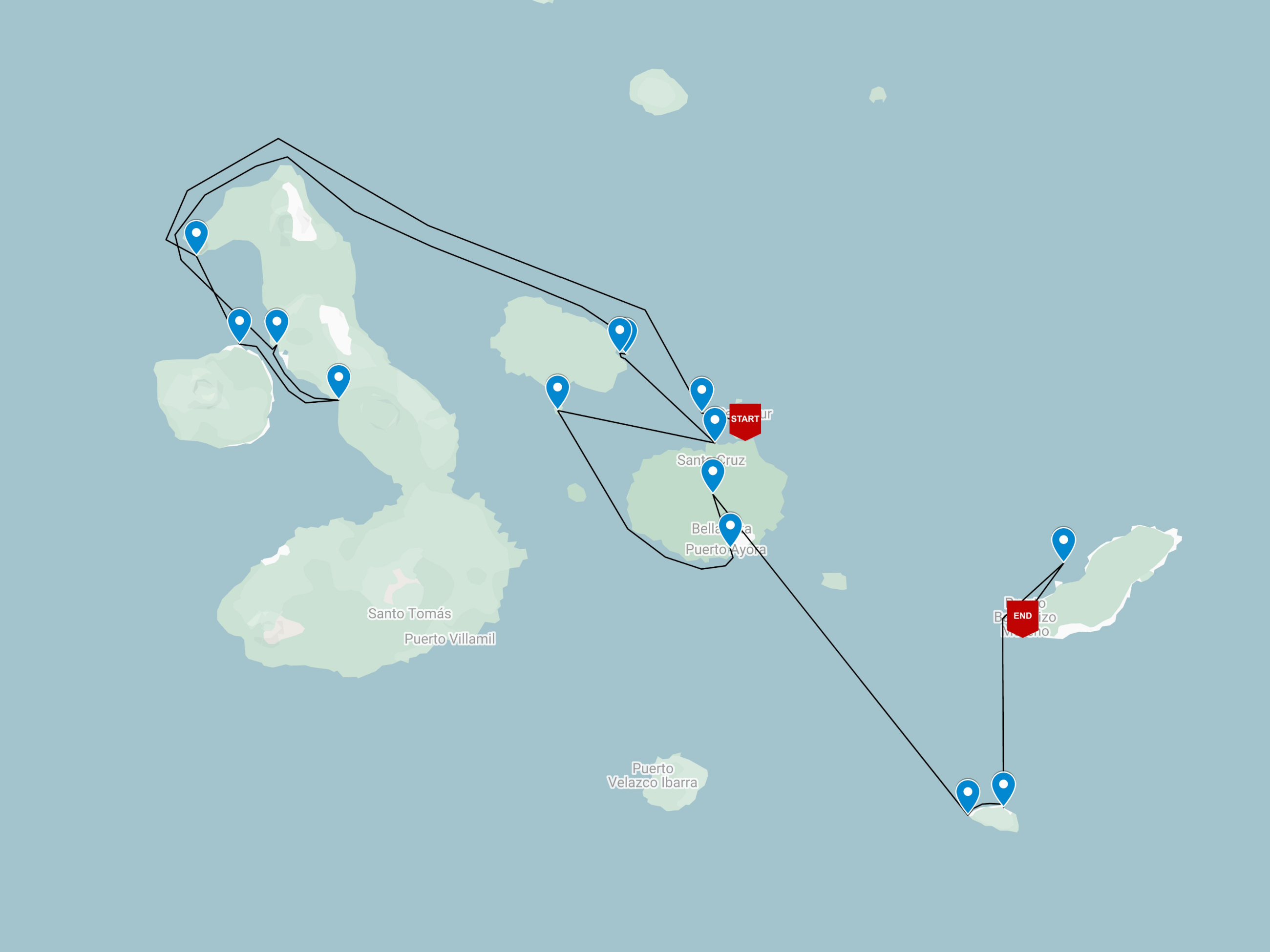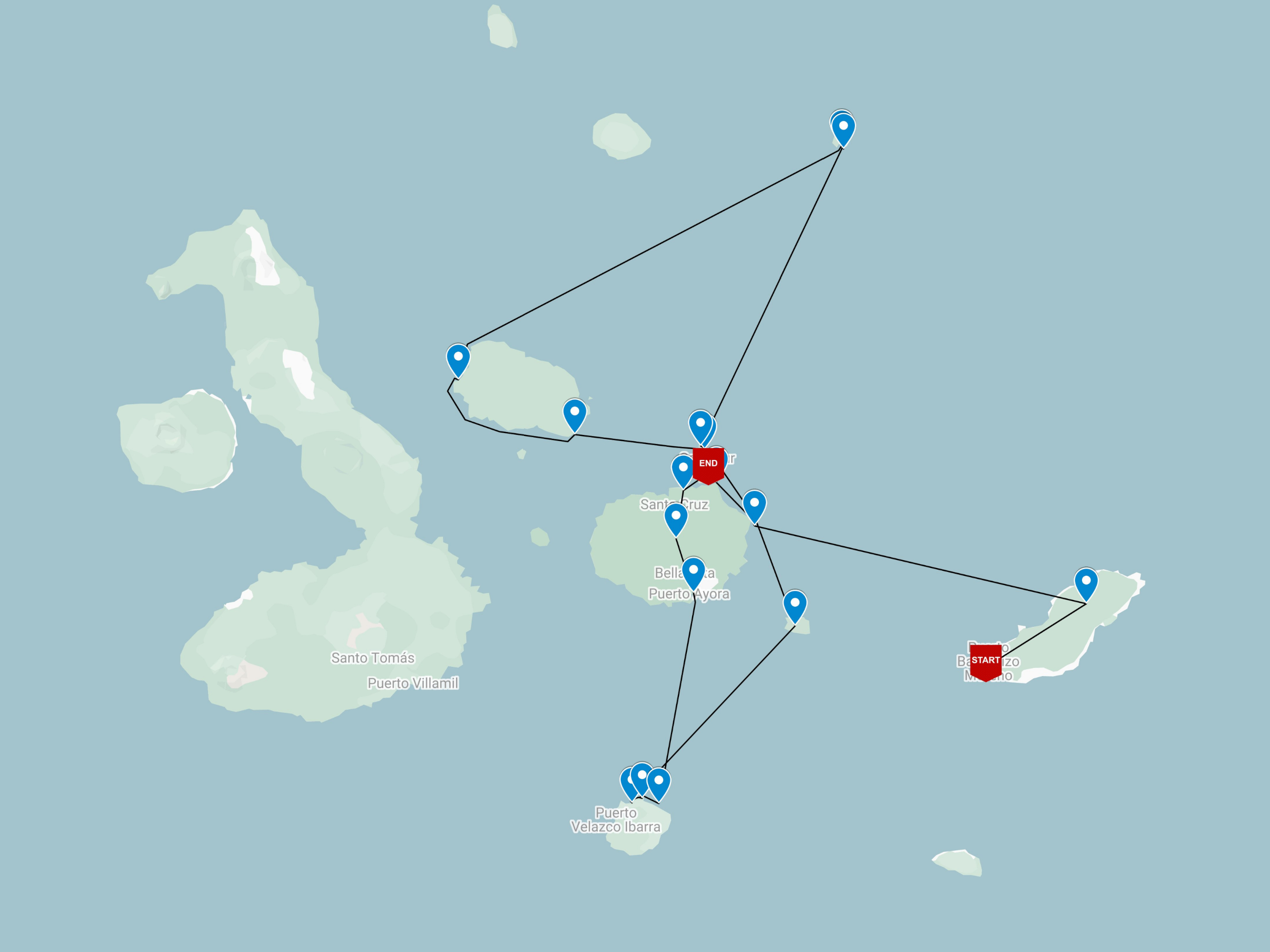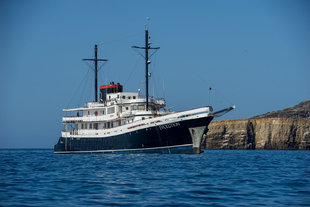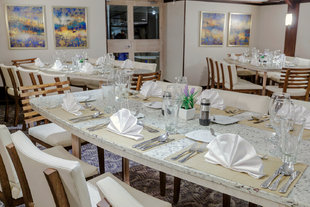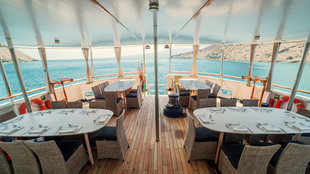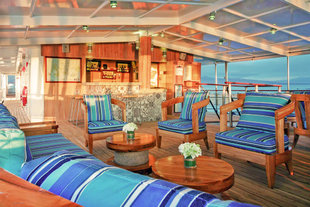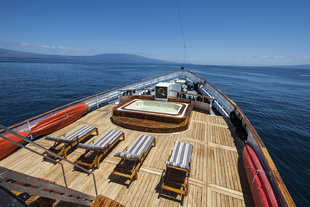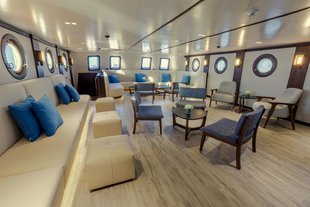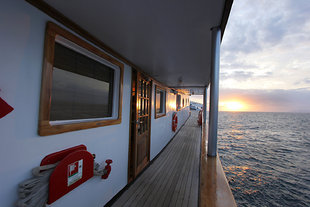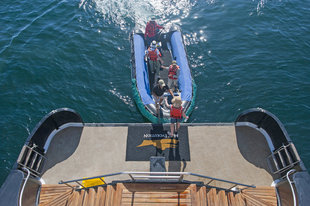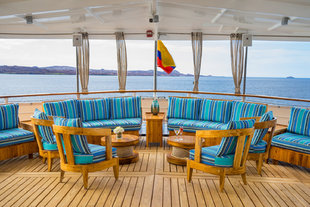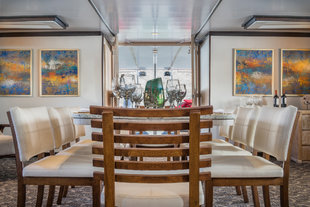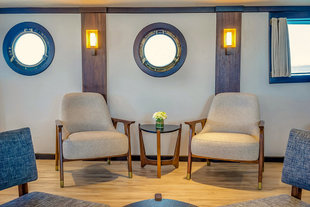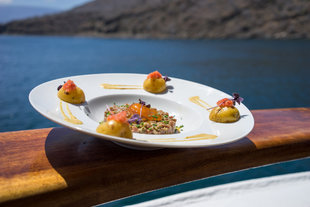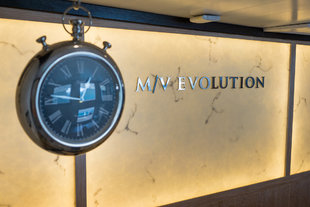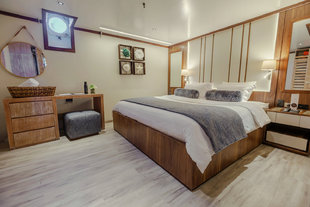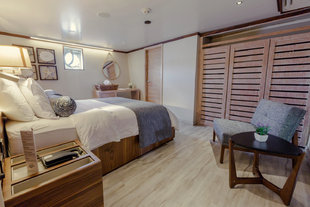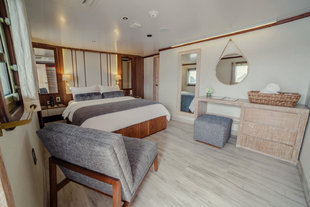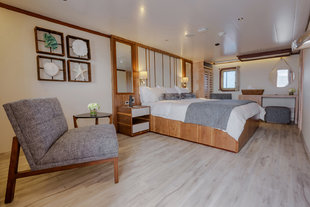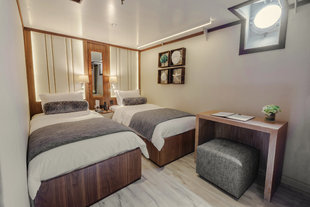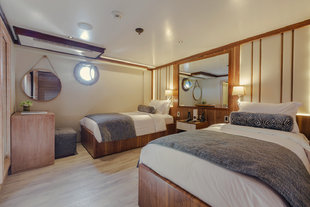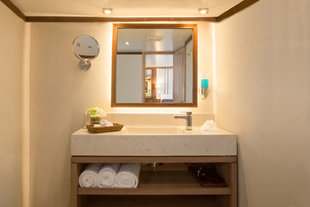Evolution is an expedition cruise vessel built with the stylish profile of a 1920s style super yacht. She has a capacity to accommodate 32 guests in 16 double or twin cabins, all of which are superbly decked out with en suite facilities, climate controls and ample storage space. Guests have the choice to in the inside dining room or in an al fresco dining area on the upper deck. The food served onboard is varied and of the highest standard and caters for vegetarians and special dietary requirements upon request, all of which is served buffet style.
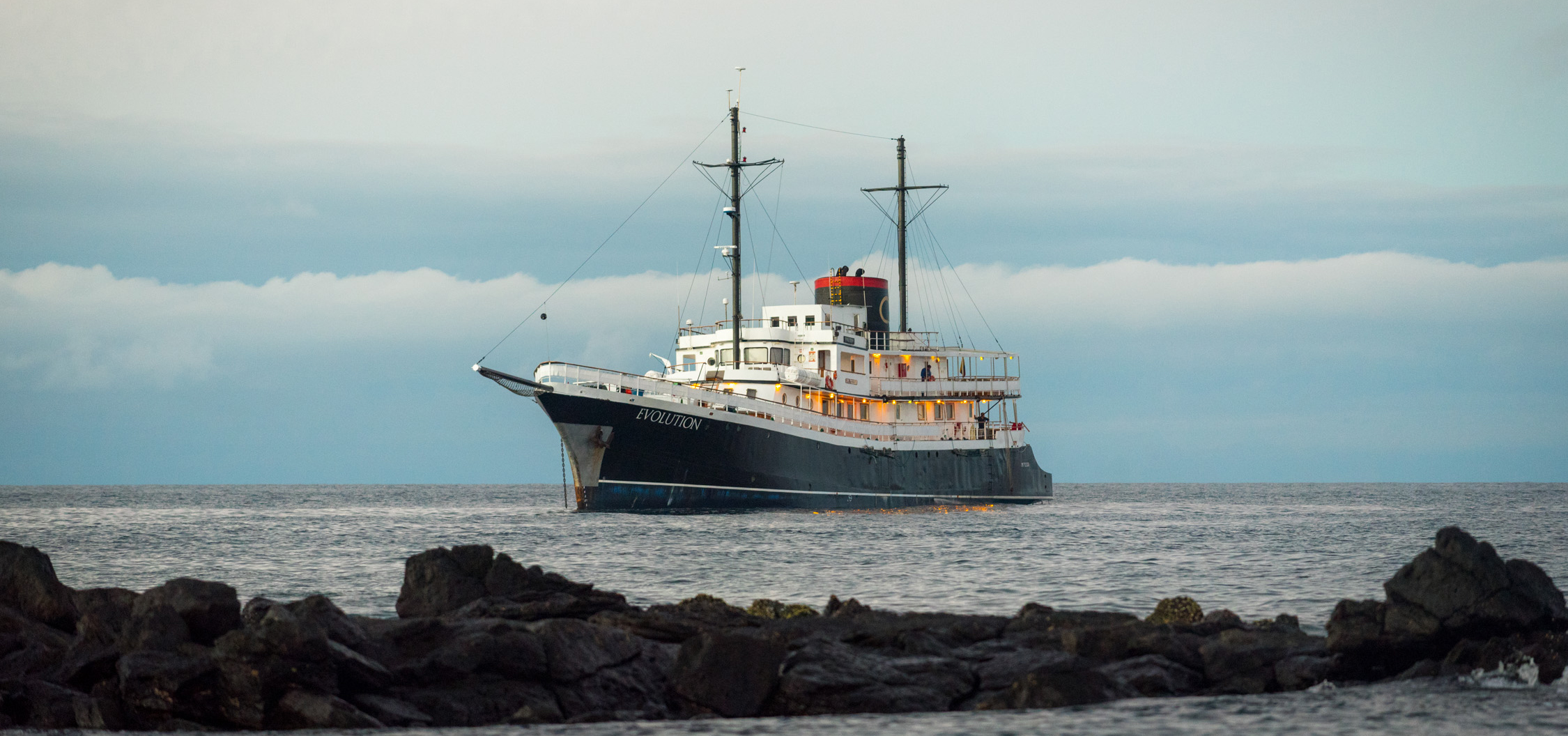
There is a considerable amount of open deck space for absorbing the island's volcanic scenery, watching out for marine life or taking the opportunity to relax. Guests have a variety of activities to choose from, since Evolution is equipped with snorkelling gear, wetsuits and sea kayaks. Guests can unwind in the onboard Jacuzzi or take in the sights of the Galapagos from the lounge chairs on the sun deck. There is a lounge area within the boat, complete with TV/stereo system, bar and excellent facilities for lectures, slide shows and films. There is also a well stocked library with books and films on the wildlife, history and flora of the islands, as well as some non-fiction 'good reads' and movies. There is also a wide range of board games available onboard.
Evolution is a good choice for families, with a specially organised Kids Club, offering activities such as star-gazing and movie nights. Guides onboard are well trained in attending to a full range of client interests, including those of children of different ages. We encourage children to consider keeping a journal of what they see, so that they can take away with them a personal expedition manual recording all that they saw and experienced. There are few places in the world where you will have the opportunity to experience wild life at such close quarters. For children and adults alike, this is an experience we hope they will savour for the rest of their lives.
Evolution has the charm and beauty of an early 20th century cruising vessel, yet all the comfort and safety of a premium small expedition cruise ship.
Wildlife & Photography
The main focus of this trip is to experience the Galapagos’ unique wildlife and landscapes above, on and below the water. All itineraries include activities like hiking, kayaking, snorkelling, panga rides and swimming on excursions which take place twice daily, helping to give you the opportunity to explore the archipelago from different perspectives.
Each of the islands provides its own individual environment due to their age differences and stages of colonisation, which can differ by millions of years. As you make your way through any of the itineraries here, you will notice gradual changes in the landscapes and wildlife which you are surrounded by. Some of the wildlife which you can hope to see here includes Galapagos Sea Lions, Marine and Land Iguanas, Nazca and Blue-Footed Boobies, Galapagos Tortoises, Galapagos Penguins and Flightless Cormorants, among many others.
The great abundance and variety of life here makes this trip ideal for photographers. There are plenty of opportunities for every photographer to get their shots – macros of sunbathing Marine Iguanas, wide-angles of Sea Lion colonies and the islands and underwater captures of Sharks and Rays are just some of the possibilities here.
Even though the trips offered here explore a lot of the archipelago’s wonders, there are many other ways which you can explore the Galapagos Islands. If you wanted to extend your stay here to experience more of this location, you could book an add-on experience, such as a dive liveaboard from our Galapagos Dive Liveaboards page or one from our Galapagos page. We also offer trips in mainland Ecuador which you could choose to experience too.
Technical Specification
| Type | Motor yacht / expeditions vessel |
| Length | 192 ft / 58.5 m |
| Beam | 29 ft / 8.9 m |
| Engines | Caterpillar 3512 TITA 1300HP |
| Generators | Northern Lights 150 KVA |
| Builder | Kanasashi Shipyard, Japan |
| Cruising speed | 10-12 knots |
| Cabins | – 3 × suites on A deck – 9 × premium staterooms on C deck – 4 × deluxe staterooms on D deck |
| Crew | 18 + up to 2 naturalist guides & 1 cruise director |
| Dinghies | 3 × dinghies (2 × 16-person & 1 × 12-person) |
| Navigation equipment | 72-mile Furuno radar 19-53 CBB Navnet, Furuno GPS satellite navigator system, Furuno depth sounder, Simrad HS50 electronic gyrocompass, speed & distance log, compasses, barometers, forward-facing echo sounder |
| Onboard safety equipment | EPIRB (Emergency Position Indicating Radio Beacon, 4 × 25-person open sea life rafts, life jackets, flares & signals, fire extinguishing & sprinkler system |
| Comfort equipment | Air renewal system, air-conditioning, TV / CD / VCS / DVD / PS2, boutique, infirmary with MD onboard, small hot tub |
| Communications equipment | UHF, VHF radio & satellite phones |
| Electricity | 110V AC 60Hz |
Deck Plan
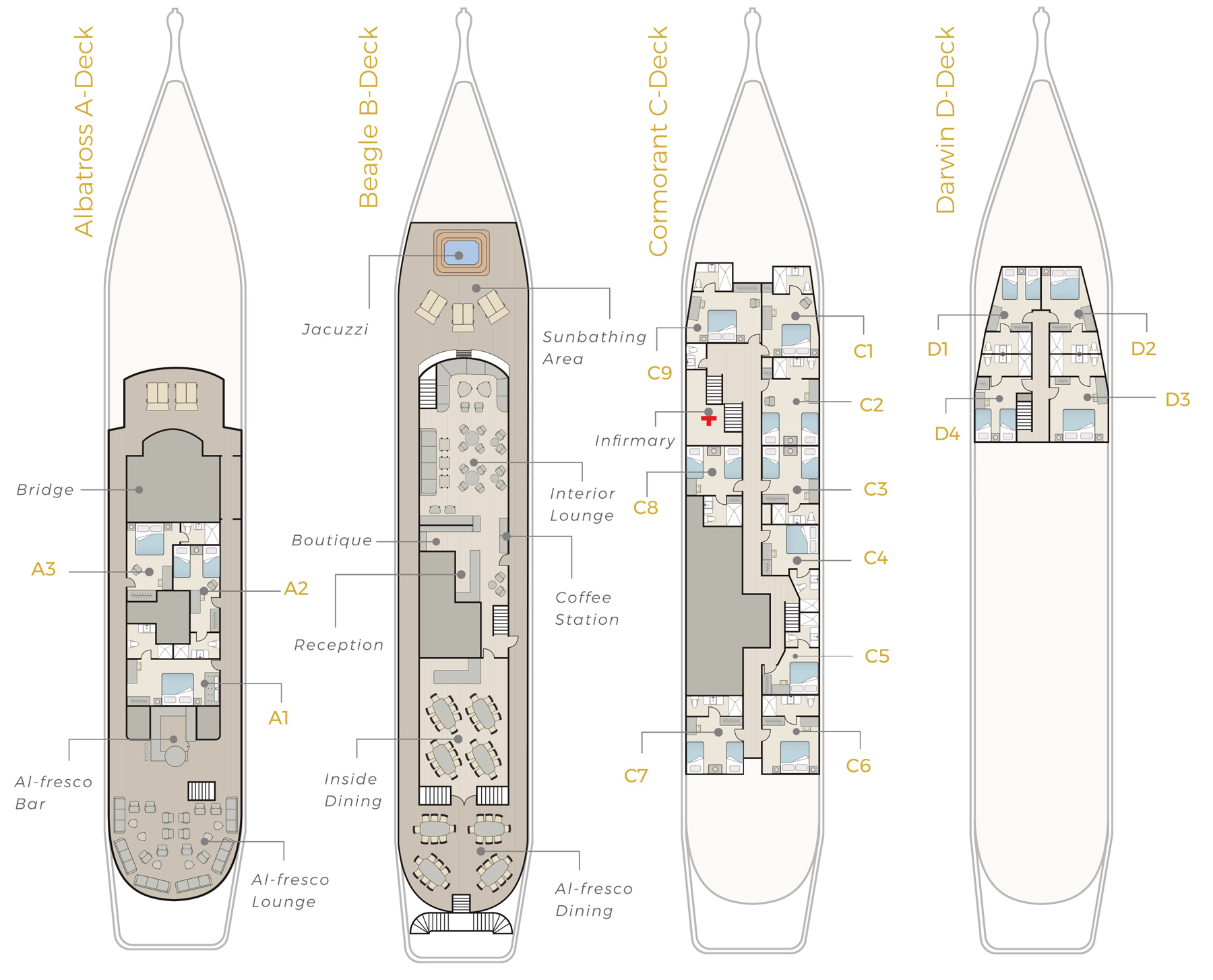
Itinerary
Each itinerary is designed as just a single part of your Galapagos experience and are combinable. We recommend combining itineraries for a more comprehensive visit to the Galapagos Islands.
Please note that these itineraries are subject to change without notice due to seasonal changes, last minute weather conditions and the decision of the Galapagos National Park authority.
Day 1 (Saturday) – Arrival & Daphne Island / Bahia Borrero
AM: Arrival, Baltra Island
Upon arrival Baltra, travellers pass through an airport inspection point to make sure that no foreign plants or animals are introduced to the islands, and to pay the park entrance fee of $200 (unless it has been prepaid). A guide will meet you, help you collect your luggage and escort you on a short bus ride to the harbour.
PM: Isla Daphne Mayor or Bahia Borrero
The Daphne Islands are just north of Santa Cruz Island and are only visited by a few permit holders operating in the Galapagos. Daphne Major is the only Daphne Island which people are allowed to land on, providing great wildlife sightings of Nazca and Blue-Footed Boobies’ nesting sites, as well as those of Red-Billed Tropicbirds. Daphne Major also gives a great view of Daphne Minor, a tuff-cone northeast of Isla Daphne Mayor.
Bahia Borrero is a beach on the north coast of Santa Cruz Island where mangroves dominate the coastline. These provide refuge for an abundance of marine life, including Sea Turtles, Reef Sharks, Tropical Fish and Rays. The mangroves also provide habitat for many bird species too.
Day 2 (Sunday) – Vicente Roca Point & Espinosa Point
AM: Punta Vicente Roca, Isabela Island
There are great snorkelling opportunities at Vicente Roca Point thanks to upwelling cold-water currents here. Marine life in the area includes various Shark species, Galapagos Penguins, Seahorses & Mola-Mola. Other animals which you can hope to see here are Nazca & Blue-Footed Boobies, Brown Pelicans & Flightless Cormorants.
PM: Punta Espinoza, Fernandina Island
Fernandina is the third largest island in the archipelago and has a single visitor site: Punta Espinoza, located at the northeastern tip of the island. Here, marine iguanas conglomerate in larger groups than on any other island. They bask around in the sand, swim near the shore and sometimes block the way at the landing dock. Among the unique species found here, we can find the flightless cormorant.
Day 3 (Monday) – Urbina Bay & Tagus Cove
AM: Urbina Bay, Isabela Island
Urbina Bay is on the west coast of Isabela and has a recently uplifted seabed which has forced corals up above the water’s surface, providing a unique snorkelling experience. There are 2 treks at this bay which offer chances of seeing Galapagos Tortoises & large Land Iguanas amongst other wildlife including Flycatchers, Finches & Mockingbirds.
PM: Tagus Cove, Isabela Island
A tour along the cliffs will give visitors a good chance to see the Galapagos penguin, the flightless cormorant and other seabirds. From the landing dock, it is about a 30-minute hike along the trail up to the top of the cliff from where you can view Darwin Lake, an uplifted lake saltier than the sea. You can also see several volcanoes from this location. Look carefully at the graffiti on the surrounding cliffs of the cove, done by pirates, whalers and buccaneers in past centuries!
Day 4 (Tuesday) – Bartolomé & Sullivan Bay
AM: Bartolomé Island
One of the Galapagos’ most iconic locations, the beautiful volcanic islet of Bartolomé is among the youngest islands in the archipelago. On a geological scale Bartolomé was only recently born out of volcanic activity. Although at first sight lifeless, Bartolomé offers some of the wildest landscapes and best panoramas of the entire archipelago. To enjoy the postcard view of the idyllic Pinnacle Bay, you have to climb steps to a viewpoint on top of the island (114 m / 375 ft). Enter a dramatic world of threatening (though extinguished) nearby spatter cones, craters, and lightweight lava droplets that have been spewed out by fiery fountains. The Summit Trail is also ideal for witnessing how scanty pioneer vegetation such as lava cacti manage to take root on the bare virgin lava fields.
PM: Sullivan Bay, Santiago Island
Setting foot at the lava stream covering Sullivan Bay is like landing on the moon. The desolate, stretched out lava fields seem mostly lifeless, but there is plenty to see on this highly popular site, with lots to photograph. Pacific green turtles seasonally bury eggs in the tiny white sand beach, where you might also encounter crabs, a stray blue heron or an American oystercatcher. On the lava flows sparse pioneer vegetation such as lava cacti and carpetweed are able to grow. You might also encounter a lava lizard, locusts or a small species of snake called the Galapagos racer.
Day 5 (Wednesday) – Bachas Beach & Rábida
AM: Playa las Bachas, Santa Cruz Island
These two small beaches are found to the west of Turtle Cove. Their sand is made of decomposed coral, which makes it white and soft, and a favourite nesting site for sea turtles. Behind one of the beaches there is a small brackish water lagoon, where it is occasionally possible to observe flamingos and other coastal birds, such as black-necked stilts and whimbrels.
The other beach is longer, but it has two old barges that were abandoned during World War II, when USA used Baltra Island as a strategic point from which to protect the Panama Channel. The rocky shoreline can be a great place to photography Sally Lightfoot Crabs.
PM: Rábida Island
Rábida Island is unique because of the red colour of the rocks and sand. The volcanic material on this island is very porous and external factors such as rain, saltwater and sea breeze have acted as an oxidising agent. A short walk along a trail leads us to a coastal lagoon behind the beach where we can see land birds including finches, doves, yellow warblers and mockingbirds; seabirds such as pelicans, masked and blue-footed boobies; and of non-feathered species you can hope to see marine iguanas and sealions. Our team will take you to a small brackish lagoon where you can anticipate a colony of flamingos.
Day 6 (Thursday) – Twin Craters / Highlands & Darwin Station
AM: Twin Craters & Highlands, Santa Cruz Island
The Twin Craters are 2 large sinkholes formed by the collapse of rock over a lava tube. The fertile volcanic soils here have made the Twin Craters heavily vegetated, in turn supporting lots of birdlife. Common sightings in the area include Vermillion Flycatchers, Short-Eared Owls & the Galapagos Dove.
The road to the highlands leaves from Bellavista, a small village located a 15-minute drive from Santa Cruz’ main town of Puerto Ayora. The road passes through the Galapagos’ most productive agricultural zone, up to the National Park boundary. We find Miconia vegetation at this altitude, changing to the Fern and Sedge zone as we ascend further. With clear weather, we can enjoy beautiful scenes of rolling hills and extinct volcanic cones covered with grass and lush greenery all year round. In the Highlands is El Chato Reserve, where Giant Galapagos Tortoises can be observed in the wild – the iconic species which gave the Galapagos Islands their name. Other species to see at this reserve include Short-Eared Owls, Yellow Warblers & Finches. More elusive species which can be difficult to spot here are Galapagos Rails & Paint-Billed Crakes.
PM: Charles Darwin Research Station, Santa Cruz Island
Although the great majority of Galapagos visitors come to the Charles Darwin Research Station to observe and appreciate natural wonders, it is also interesting to learn how the protection and conservation of the islands are carried out. The main attractions are the National Park information centre, the Van Staelen Exhibition Hall, the Breeding and Rearing Centre for young tortoises, and adult Galapagos tortoises in captivity.
Day 7 (Friday) – Suarez Point & Gardner Bay
AM: Punta Suarez, Española Island
Huge ocean waves crash onto the southern basaltic cliffs of Suarez Point, forming a spectacular blowhole. where the water sprays metres high into the air (depending on the season, the tide and how strongly the sea breeze pushes the waves). This location is home to the only breeding colony of Waved Albatross in the Galapagos. You can also see wildlife such as marine iguanas, Nazca and Blue-Footed Boobies. Take your time for a meditative break in silence at this emblematic viewpoint and convert this unforgettable moment in a lifetime experience.
PM: Gardner Bay, Española Island
The striking white beach at Gardner Bay is an important breeding site for Pacific green turtles. However, without doubt its main attraction is the Galapagos sea lion colony. Females stay year-round in this nursery, suckling their pups up to an age of 3 years, although they start to fish after 5 months of their birth. During the breeding and mating season, the colony becomes even bigger.
Day 8 (Saturday) – Kicker Rock / Interpretation Centre & Departure
AM: Kicker Rock & Interpretation Centre, San Cristobal Island
Kicker Rock is the remnant of a volcanic tuff cone about a 90-minute boat ride out from San Cristobal Island. Its sheer cliffs rise 150 metres above the sea surface, all around and through a giant split between its two sections. Above water, the rock itself and birdlife are of interest, with bird species such as Blue-Footed Boobies, Frigatebirds & Red-Billed Tropicbirds.
The San Cristóbal Interpretation Centre just outside the provincial capital of Puerto Baquerizo Moreno, is a perfect complement to the field explanations and briefings of your naturalist guide and host. Information panels are in English and Spanish, with many photographs, models and true to life dioramas which tell the background story of the islands in different ways. They really capture what makes the Galapagos Islands so unique. The well-maintained botanical garden with native species from the arid zone (including the giant prickly pear and candelabra cacti) is worth your visit as well; and you will probably spot the Chatham Mockingbird which is endemic to this island - a bird which put Darwin on track to his theory of evolution. The attractive exhibition is quite complete and explains a series of natural circumstances that create the Galapagos’ unique environment: such as the volcanic genesis of the islands, their remoteness from the continent, its ocean currents, its special climate, the arrival of different species, and their establishment, among others. It also recounts historic discovery and attempts of colonisation; and shows a diorama with ancient mail barrels from Post Office Bay.
PM: Departure, San Cristobal Island
Your guide and some crew members will accompany you back to San Cristobal where you will take the airport shuttle. Your guide will remain with you through check-in counters & the departure hall.
Day 1 (Saturday) – Arrival & Witch Hill
AM: Arrival, San Cristobal Island
Land at San Cristobal airport where you will be directed towards the airport terminal building. You will need to queue here to pay your Galapagos National Park fee and have your luggage inspected for potential contaminants to the island, such as plant matter or seeds.
Please wait for you baggage to be unloaded. Collect it and then look for someone holding a card with your name or the name of your Galapagos yacht: Evolution.
PM: Cerro Brujo, San Cristobal Island
The primary attraction of this site is the coral sand beach, an excellent place to swim and snorkel. Witch Hill is the remains of a tuff cone and one of the first sites visited by Charles Darwin. It has an impressive landscape, where it is often possible to see coastal and migratory birds, including pelicans, blue-footed boobies and swallow-tailed gulls. There are sealions and marine iguanas here too. At times, the lagoon is completely dry and deposits of salt can be found at the bottom. The people of Puerto Baquerizo Moreno used to use the lagoon as a salt mine.
Day 2 (Sunday) – South Plaza & Carrion Point / Mosquera
AM: South Plaza Island
South Plaza is a beautiful island formed out of lava which bubbled up to the sea surface. It is relatively small but very diverse in its botany and very good for spotting Land Iguanas. hybrid Iguanas exist here, created through the mating of male marine iguanas and female land iguanas.
There are approximately 1,000 Galapagos Sealions on the island and birdlife is plentiful. Cliffs on the western side are nesting sites for Blue-footed and Nazca Boobies, whilst we can find Darwin's Finches amongst the rocks of the eastern side, Lava Gulls and lovely Swallow-tail Gulls. Red-billed Tropicbirds often swoop low overhead, whilst in the sea beneath the western cliffs we can often see schools of fish close to the surface.
This island can be one of the best for photography.
PM: Punta Carrion, Santa Cruz Island, & Mosquera Island
On the far northeast coast of Santa Cruz, we find a fantastic snorkelling area called Punta Carrion. A rock wall provides dozens of hiding places for white-tip reef sharks and stingrays to hide. Inside this wall lies a calm bay with an overhang where we might find sharks resting on the white sand.
Mosquera is a low white sand island which lies in the Itabaca Channel between Baltra Island (South Seymour) and North Seymour. It is surrounded by coral reefs, providing protected conditions for snorkelling and scuba diving. Above water, it has a large sealion colony and is good for spotting birds like America oyster catchers, blue-footed boobies and lava gulls.
Day 3 (Monday) – Chinese Hat & Egas Port
AM: Sombrero Chino
Sombrero Chino, or Chinese Hat, aptly named due to its slowly sloping sides giving the island an appearance resembling that of a Chinese hat, is one of the smallest in the peninsula. The recent formation of the island gives it a unique environment where there are different stages of colonisation by pioneer species at this location compared to others you will have visited. Walking on the island is a great way to experience the island’s wildlife, including Sally Lightfoot Crabs, Marine Iguanas, Galapagos Sea Lions & Lava Lizards. Out of the cracks in dried-up lava, lava cacti are a common sight. The waters of the island are calm & home to White-Tip Reef Sharks, so there is ample opportunity for snorkelling & kayaking here too.
PM: Puerto Egas, Santiago Island
Puerto Egas is a black beach located at the west side of Santiago Island. Volcanic tuff deposits formed this special black sand beach and made it the main attraction of the Island. This site is called Puerto Egas because Hector Egas attempted to exploit the salt, which failed because the price of salt on mainland South America was too low to make it a viable export. There is a trail which follows the coastline here for sightings of Marine Iguanas, Galapagos Sea Lions and many sea birds. Land Iguanas were reintroduced to the island as recently as 2019, so look out for these as you walk. At the end of the trail is a small Galapagos Fur Seal colony. If you snorkel from the beach here, you may be able to see Turtles, a range of Fish and Reef Sharks.
Day 4 (Tuesday) – Darwin Bay & Prince Philip’s Steps
AM: Darwin Bay, Genovesa Island
Inside the submerged caldera of Genovesa lies Darwin Bay, whose diameter is more than 1.5 km (1 mile) and it is almost 200 m (650 ft) deep. The small area will surprise you repeatedly, walking along a coral sand beach, crossing barren lava formations and creeks, passing tidal pools, shrubs and further ahead following the top of some cliffs. With this peaceful surrounding, every species has occupied its own ecological niche (or habitat) without disturbing others. There is great birdlife here with starring species including Red-Footed Boobies, Great Frigatebirds & Laval Gulls. These often share the beach with Galapagos Sea Lions.
PM: El Barranco, Genovesa Island
Before landing, you will take an inflatable dinghy-ride along the eastern arm of the caldera. As we approach, the soaring 25 m / 80 ft high walls become overwhelming. Sometimes, a Galapagos fur seal is resting or a seabird is nesting on one of the ledges at the base. You will then have to hike and overcome the steep stairs from the landing dock to a bush of palo santo shrubs on top. Red-footed boobies gratefully use these scarce nesting places so that they don’t have to nest on the rocky ground. Upon arriving at the edge of the rim, the bushes open up and you can enjoy panoramic views, a sea breeze and the amazing flying skills of countless seabirds. Following the exposed rim, you will first pass a place where we usually encounter a colony of Nazca boobies; and finally reach the extensive storm petrel nesting places. If you are lucky, you can spot the well camouflaged short-eared owl hunting for them on foot!
Day 5 (Wednesday) – North Seymour & Santa Fé
AM: North Seymour Island
This islet is one of most visited sites in the Galapagos and it is teeming with birdlife. An easy circular path takes you through the archipelago’s most extensive colonies of blue-footed boobies and frigate birds. At the beginning of the breeding season, adult frigatebird-males blow up their vivid red pouches (gulas) to impressive football-sized balloons. This is one of the few spots where you can compare the magnificent and the great frigatebird breeding next to each other.
You are likely to come across several land iguanas on North Seymour and the coast can be a good place to spot Galapagos sealions.
PM: Santa Fé Island
Located in the southeastern part of the Galapagos, this island was formed from an uplift rather than being from a volcanic origin, which is why it is mostly flat. There are some theories claiming that this could be the oldest island in the archipelago. Santa Fé is home to a number of endemic species like the Galapagos Hawk, Galapagos snake, Galapagos mockingbird, rice rats and one of the two species of land iguanas on the islands. After disembarking into the beautiful and clear waters, you will be in contact with one of the many sea lion colonies. Along the trail, many saltbushes can be seen, as well some particularly impressive giant Opuntia cacti ‘trees’.
The island is some 24 km2 in area and a maximum 60 metres above sea level. The waters which surround it can be a lovely turquoise blue, with a protective barrier of rocks creating a semi-lagoon which is ideal for humans and sealions alike for swimming and snorkelling.
Day 6 (Thursday) – Post Office Bay & Cormorant Point / Champion Islet
AM: Post Office Bay, Floreana Island
Post Office Bay is primarily of cultural significance. In times before there was a reliable postal service, a barrel onshore was a point where British 16th century whalers and poachers could post a letter. You are encouraged to write and address one or two post cards; whilst at the same time picking out any which are addressed close to your home, which you are happy to hand deliver when you return.
Shallow waters offshore are lovely to swim in. If you doon a mask and snorkel, you might see Pacific green turtles which often graze here.
PM: Punta Cormorant & Champion Islet, Floreana Island
The peninsula of Punta Cormorant (Cormorant Point) marks the extreme northern cape of Floreana – an island formed from smaller volcanic cones, covered now by tropical dry forest (palo santo). At the landing beach, you are likely to be welcomed by a small colony of Galapagos sealions. The green sand on this beach contains a high percentage of glassy olivine crystals which have been blown out by the surrounding tuff cones.
The ‘flour sand’ beach on the southern side of the peninsula is made up of white coral ground into sand by Parrotfish. It feels very smooth on the feet. You may be able to spot stingrays who use the sandy bottom to bury themselves. During the first months of the year, Pacific green turtles come ashore to dig a nest in which to bury their eggs.
Bottlenose dolphins frequently escort our passage to Champion Islet and you can see them from nearby jumping the bow wave. Underwater, Galapagos sea lions are playful acrobats that become the number one attraction. There are also lots of reef fish, and perhaps a green Pacific turtle. An inflatable dinghy ride along the shoreline of this islet offers sightings of lots of seabirds that are endemic to the archipelago, including Galapagos penguins, blue-footed boobies, magnificent frigate birds and red-billed tropicbirds, swallow-tailed gulls and lava herons. A birdwatcher’s dream is to get a glimpse of the Charles mockingbird on top of Opuntia cacti. This mockingbird is a scientific and historic key species, because it put Darwin on track of his theory of 'adaptive radiation'.
Day 7 (Friday) – Darwin Station & Highlands
AM: Charles Darwin Research Station, Santa Cruz Island
Although the great majority of Galapagos visitors come to the Charles Darwin Research Station to observe and appreciate natural wonders, it is also interesting to learn how the protection and conservation of the islands are carried out. The main attractions are the National Park information centre, the Van Staelen Exhibition Hall, the Breeding and Rearing Centre for young tortoises, and adult Galapagos tortoises in captivity.
PM: Highlands, Santa Cruz Island
The road to the highlands leaves from Bellavista, a small village located a 15-minute drive from Santa Cruz’ main town of Puerto Ayora. The road passes through the Galapagos’ most productive agricultural zone, up to the National Park boundary. We find Miconia vegetation at this altitude, changing to the Fern and Sedge zone as we ascend further. With clear weather, we can enjoy beautiful scenes of rolling hills and extinct volcanic cones covered with grass and lush greenery all year round. In the Highlands is El Chato Reserve, where Giant Galapagos Tortoises can be observed in the wild – the iconic species which gave the Galapagos Islands their name. Other species to see at this reserve include Short-Eared Owls, Yellow Warblers & Finches. More elusive species which can be difficult to spot here are Galapagos Rails & Paint-Billed Crakes.
Day 8 (Saturday) – Black Turtle Cove & Departure
AM: Caleta Tortuga Negra, Santa Cruz Island
Black Turtle Cove offers engineless activities, so you will explore it by dinghy, paddling across the mangrove forested coastline of this stretch of Santa Cruz. There is great wildlife here due to the high levels of protection of this environment such as Sea Turtles, Pelicans & Sharks.
PM: Departure, Baltra Island
Your guide & some crew members will go with you to Baltra where you will board the airport shuttle. Your guide will remain with you through the check-in counters & departure hall.
Dates
Itinerary B – Footsteps Back in Time (8 days / 7 nights)
Itinerary A – In the Steps of Pirates & Darwin (8 days / 7 nights)
Itinerary B – Footsteps Back in Time (8 days / 7 nights)
Itinerary A – In the Steps of Pirates & Darwin (8 days / 7 nights)
Itinerary B – Footsteps Back in Time (8 days / 7 nights)
Itinerary A – In the Steps of Pirates & Darwin (8 days / 7 nights)
Itinerary A – In the Steps of Pirates & Darwin (8 days / 7 nights)
Itinerary B – Footsteps Back in Time (8 days / 7 nights)
Itinerary A – In the Steps of Pirates & Darwin (8 days / 7 nights)
Itinerary B – Footsteps Back in Time (8 days / 7 nights)
Itinerary A – In the Steps of Pirates & Darwin (8 days / 7 nights)
Itinerary B – Footsteps Back in Time (8 days / 7 nights)
Itinerary A – In the Steps of Pirates & Darwin (8 days / 7 nights)
Itinerary B – Footsteps Back in Time (8 days / 7 nights)
Itinerary A – In the Steps of Pirates & Darwin (8 days / 7 nights)
Itinerary B – Footsteps Back in Time (8 days / 7 nights)
Itinerary A – In the Steps of Pirates & Darwin (8 days / 7 nights)
Itinerary B – Footsteps Back in Time (8 days / 7 nights)
Itinerary A – In the Steps of Pirates & Darwin (8 days / 7 nights)
Itinerary B – Footsteps Back in Time (8 days / 7 nights)
Itinerary A – In the Steps of Pirates & Darwin (8 days / 7 nights)
Itinerary B – Footsteps Back in Time (8 days / 7 nights)
Itinerary A – In the Steps of Pirates & Darwin (8 days / 7 nights)
Itinerary B – Footsteps Back in Time (8 days / 7 nights)
Itinerary A – In the Steps of Pirates & Darwin (8 days / 7 nights)
Itinerary B – Footsteps Back in Time (8 days / 7 nights)
Itinerary A – In the Steps of Pirates & Darwin (8 days / 7 nights)
Itinerary B – Footsteps Back in Time (8 days / 7 nights)
Itinerary A – In the Steps of Pirates & Darwin (8 days / 7 nights)
Itinerary B – Footsteps Back in Time (8 days / 7 nights)
Itinerary A – In the Steps of Pirates & Darwin (8 days / 7 nights)
Itinerary B – Footsteps Back in Time (8 days / 7 nights)
Itinerary A – In the Steps of Pirates & Darwin (8 days / 7 nights)
Itinerary B – Footsteps Back in Time (8 days / 7 nights)
Itinerary A – In the Steps of Pirates & Darwin (8 days / 7 nights)
Itinerary B – Footsteps Back in Time (8 days / 7 nights)
Itinerary A – In the Steps of Pirates & Darwin (8 days / 7 nights)
Itinerary B – Footsteps Back in Time (8 days / 7 nights)
Itinerary A – In the Steps of Pirates & Darwin (8 days / 7 nights)
Itinerary B – Footsteps Back in Time (8 days / 7 nights)
Itinerary A – In the Steps of Pirates & Darwin (8 days / 7 nights)
Itinerary B – Footsteps Back in Time (8 days / 7 nights)
Itinerary A – In the Steps of Pirates & Darwin (8 days / 7 nights)
Itinerary B – Footsteps Back in Time (8 days / 7 nights)
Itinerary A – In the Steps of Pirates & Darwin (8 days / 7 nights)
For Christmas & New Years departures, a 100% supplement is applied to the per person rate for both suites and staterooms.
15% discount for children under 15 years old (max 3 child discounts per family & cannot be applied on Christmas & New Years departures).
Our prices include
Daily served meals or buffet offering a wide choice of dishes
Naturalist guides & activities throughout the cruise
All transfers (with rest of group) while in Galapagos
Select wines, local beer, cocktails, spirits, soft drinks, juice, coffee, hot chocolate, water and tea are included throughout the cruise
Lectures and entertainment onboard
Snorkelling equipment (masks, snorkels & fins) and wetsuits (3mm long wetsuit)
Kayaks and equipment
Galapagos National Park entrance fee ($100 USD adults / $50 USD children) *
Galapagos Transit Control Card ($20 USD per person) *
Internet / Wi-Fi connection throughout the cruise (within limited schedule)
A year's membership to the Galapagos Conservation Trust.
(*subject to availability)
Our prices exclude
Flights, accommodations, meals, excursions and transfers other than those included in the itinerary
International air tickets to either Quito or Guayaquil, Ecuador
Gratuities to guides, crew and staff
Extra expenses (communication, laundry, souvenirs, etc.)
Trip insurance and medical evacuation insurance
Personal travel insurance
Premium brands of wines, beer or spirits
Mainland Ecuador arrangements (we'd be delighted to arrange these for you)
Galapagos flights for your requested dates (required to be booked through Aqua-Firma)
Single Supplement
Single travellers can book a suite with a 75% supplement which is applied to the per person rate. For staterooms, a 50% supplement will be applied to the per person rate.

